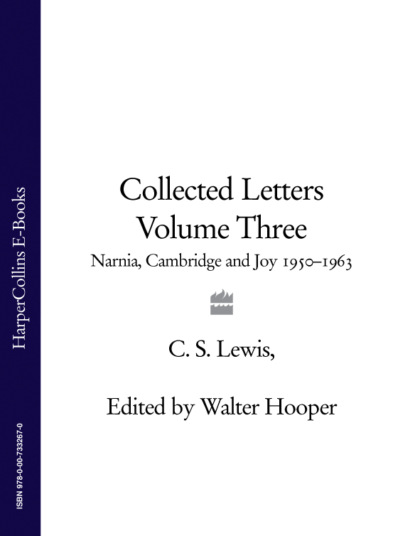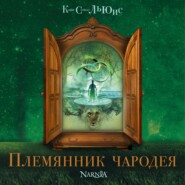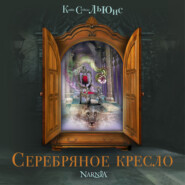По всем вопросам обращайтесь на: info@litportal.ru
(©) 2003-2025.
✖
Collected Letters Volume Three: Narnia, Cambridge and Joy 1950–1963
Настройки чтения
Размер шрифта
Высота строк
Поля
12 (#ulink_b34940ea-7f29-5103-97ca-b7182543f23e)Dymer, with a preface by the author (London: Dent; New York: Macmillan, 1950).
13 (#ulink_49f62fce-81c4-55a9-8706-d763bb409050) i.e. Lewis’s interplanetary trilogy, Out of the Silent Planet, Perelandra and That Hideous Strength.
14 (#ulink_49f62fce-81c4-55a9-8706-d763bb409050) Ludovico Ariosto (1474-1535) was the author of Orlando Furioso (1532). See The Allegory of Love, Ch 7, Sect. 1, pp. 312-13).
15 (#ulink_82a1af13-2ba6-5ba2-95e5-2ec74e417b88) Bernardus Silvestris, De Mundi Universitate, ed. Carl Sigmund Barach and lohann Wrobel (Innsbruck: Verlag der Wagner’schen Universitats-Buchhandlung, 1876).
16 (#ulink_39c60c9d-1950-5b86-8ed9-95b930423a72) Dwight D. Eisenhower (1890-69), American general and President of the United States, 1953-61, who launched the invasion of Normandy on 6 June 1944 and oversaw the final defeat of Germany. In 1950 President Truman asked Eisenhower to become supreme commander of the North Atlantic Treaty Organization (NATO), and in 1951 he flew to Paris to assume his new position. For the next fifteen months he devoted himself to the task of creating a united military organization in western Europe to be a defence against the possibility of Communist aggression.
17 (#ulink_41ccd86d-942c-5aae-8d5f-a562294dfbad) On Mrs Alice Hamilton Moore (1853-1939), see CL II, p. 281n.
18 (#ulink_84e065e0-3e6d-5e0f-91da-e14306898614) Rider Haggard, She (1887); Ayesha (1905); She and Allan (1921); Wisdom’s Daughter (1923).
19 (#ulink_ffd7e1b6-586e-5b18-a5b2-9e29844003d1) After Greeves’s mother died in 1949 he moved from the family home, ‘Bernagh’ in Belfast, to a cottage at Silver Hill, Crawfordsburn, Co. Down, about twelve miles from Belfast. When he visited Arthur there, Lewis always stayed at the Old Inn, Crawfordsburn.
20 (#ulink_5064ec38-0e68-5f55-b216-972f6701be70) When Roger Lancelyn Green’s father died in 1947, Roger, his eldest son, became the 31st Lord of Poulton, and in August 1950 he moved with his wife and son from Oxford to the family home, Poulton Hall, Poulton-Lancelyn, Bebington, Wirral, Cheshire.
21 (#ulink_debecf4f-ab4f-51f5-9202-3aa70ff59127) The Festival of Britain was opened by King George VI in London on 3 May 1951, six years after the end of the Second World War. It was designed to celebrate the best of British art, design and industry, and raise the nation’s spirits after the austerity of the war years. More than eight million people visited the exhibition over a period of five months.
22 (#ulink_123cb32a-379c-538c-9587-ad7b261d1a07) Frederick lames Eugene Woodbridge, An Essay on Nature (New York: Columbia University Press, 1940).
23 (#ulink_7ba30d13-9060-56ff-b9a9-6e411d290297) See Cecil Day-Lewis in the Biographical Appendix.
24 (#ulink_7ba30d13-9060-56ff-b9a9-6e411d290297)BF, p. 239.
25 (#ulink_9262e79c-736b-59fe-98a2-d436f2d9772d) See Dr Seymour Jamie Gerald Spencer in the Biographical Appendix.
26 (#ulink_5b838ea4-c14a-5660-a2f8-fc1ab0187f3b) Eric Fromm (1900-80), German-born American psychoanalyst who studied the role of social conditioning in human behaviour.
27 (#ulink_f65c6fcb-5fa9-590b-946e-e3275fd49037) This was Lewis’s essay, ‘The Humanitarian Theory of Punishment’, in 20th Century: An Australian Quarterly Review, vol. Ill, no. 3 (1949), pp. 5-12 and subsequently in Res Judicatae, VI (June 1953), pp. 224-30, and The Churchman, LXXIII (April-June 1959), pp. 55-60. It was reprinted in First and Second Things, ed. Walter Hooper (London: Fount, 1985) and EC.
28 (#ulink_654e38c3-9fdb-5fe0-9233-15a4d4c52d5f) ‘Mrs Lockley’ is the pseudonym Warnie Lewis gave this correspondent in L and WHL. See CL II, p. 975n. The woman is yet to be identified.
29 (#ulink_876b873e-8792-5a03-aa40-3c2d92d8e133) Green had been reading the manuscript of what became The Silver Chair, and he had questioned whether the wood fire Puddleglum tramples on in Chapter 12 would go out. In the end, Lewis did not specify what kind of fire it was, and he simply let Puddleglum ‘stamp on the fire, grinding a large part of it into ashes on the flat hearth’.
30 (#ulink_8dd082c3-8a16-58a7-a301-6fd194839850) Paul Capon, The Other Side of the Sun (1950).
31 (#ulink_0491b755-8fe8-5eb6-ba59-163e248b10fb) Period of two days.
32 (#ulink_80b2964e-723d-50c9-a4f6-691d6856be76) Ruth Pitter, Urania (1950). This volume of poems was a selection from Pitter’s A Trophy of Arms: Poems 1926-35 (1936), The Spirit Watches (1939) and The Bridge (1945).
33 (#ulink_7225b9a4-bd29-500b-a2d2-c3898d01b229)Urania contains an engraving by Joan Hassall. At the feet of the Muse there is a vine branch based on those at Pitter’s farm in Essex.
34 (#ulink_7225b9a4-bd29-500b-a2d2-c3898d01b229) Thomas Traherne (c. 1636-74), Centuries of Meditation (1908), First Century, 27.
35 (#ulink_c2d32de4-ec9b-544b-b5d2-ad8eba8ca6bd) See Colin and Christian Hardie in the Biographical Appendix. In ‘Three Letters from C. S. Lewis’, The Chesterton Review, XVII, nos. 3 and 4 (August/November 1991), p. 393, Christian Hardie commented: ‘The three letters…relate to the two novels which I lent to C. S. Lewis. He had revealed one day at lunch with us, that he had read no book by Evelyn Waugh or Graham Greene. I said that he should try to catch up with the contemporary scene, and that I would lend him some books which were currently read and admired. The first, in March 1951, was Brideshead Revisited. Treating this as a Lenten penance, a year later he asked for another and got The Power and the Glory. He could easily have returned the books with only a verbal message; characteristically, he took the trouble to write a letter.’
36 (#ulink_187b63b7-e672-5335-8079-31f9e8b9d3ca) Lewis took Hardie’s advice and read Evelyn Waugh’s Brideshead Revisited (1945). The novel is told in the first person by Charles Ryder, a fellow-student at Oxford of Lord Sebastian Flyte, a member of an ancient Roman Catholic family. Sebastian takes Charles to the home of his family, Brideshead Castle, where he meets the rest of the Flyte family. Sebastian has an elder brother, Lord Brideshead, and two sisters, Julia and Cordelia. His mother, the devout Lady Marchmain, refuses to divorce Lord Marchmain, who is living in Venice with his mistress. Lady Marchmain attempts to enlist Charles’s help in preventing Sebastian’s drinking, but Sebastian escapes to North Africa where, after his mother’s death, he becomes a saintly down-and-out. Charles falls in love with Lady lulia, but in the end the power of the Church reclaims her and they part for ever.
37 (#ulink_346ecbac-c104-5577-96fe-83b13a72aa56) Samuel Butler, Erewhon (1872).
38 (#ulink_346ecbac-c104-5577-96fe-83b13a72aa56) Sir Walter Scott, Rob Roy (1817).
39 (#ulink_346ecbac-c104-5577-96fe-83b13a72aa56) James Hogg, The Private Memoirs and Confessions of a Justified Sinner (1824).
40 (#ulink_346ecbac-c104-5577-96fe-83b13a72aa56) Stephen McKenna, The Confessions of a Well-Meaning Woman (1922).
41 (#ulink_a59518f4-e22e-5f10-b98d-c1613768618f) G. K. Chesterton, Orthodoxy (1909), ch. 2: ‘You can make a story out of a hero among dragons; but not out of a dragon among dragons.’
42 (#ulink_e3d2e3a8-61a5-5129-b3d6-4b548d479d0f) When Charles Ryder is stationed near Brideshead Castle near the end of the war, one of his platoon commanders is named Hooper. The man epitomizes everything Ryder—and Waugh—hate. ‘In the weeks that we were together,’ says Charles in the Prologue to Brideshead Revisited, ‘Hooper became a symbol to me of Young England, so that whenever I read some public utterance proclaiming what Youth demanded in the Future and what the world owed to Youth, I would test these general statements by substituting “Hooper” and seeing if they still seemed as plausible.’
43 (#ulink_e3d2e3a8-61a5-5129-b3d6-4b548d479d0f) Constantin Levin is a character in Leo Tolstoy, Anna Karenina (1873-82).
44 (#ulink_e3d2e3a8-61a5-5129-b3d6-4b548d479d0f) Characters in Leo Tolstoy, War and Peace (1863-9).
45 (#ulink_e3d2e3a8-61a5-5129-b3d6-4b548d479d0f) Archdeacon Grantly is a prominent character in the ‘Barsetshire’ novels of Anthony Trollope.
46 (#ulink_e3d2e3a8-61a5-5129-b3d6-4b548d479d0f) Benjamin Disraeli, Coningsby (1844).
47 (#ulink_a03c0492-d7b3-5438-bc1d-5fd862de1534) Edward Frederic Benson (1871-1914), whose novels include Dodo (1893).
48 (#ulink_867cbe84-3900-5550-b302-17655fae7a04) Railway.
49 (#ulink_867cbe84-3900-5550-b302-17655fae7a04) Lewis was planning to travel the (roughly) twelve miles from Oxford Street, Belfast, to Helen’s Bay, near Crawfordsburn.
50 (#ulink_720a6d9a-2f24-5352-82b7-ace47094a534) Douglas Edison Harding (1909–) was born in Lowestoft, Suffolk, on 12 February 1909 and educated at Lowestoft Grammar School and University College, London. In a letter to Walter Hooper of 11 August 2005, he said: ‘My parents were Exclusive Plymouth Brethren. I apostacised from them at the ripe age of 21. Though I earned my living as an architect, my real job and passion has been the Perennial Philosophy and research into my True Identity, plus sharing my discoveries with as many people as possible worldwide by means of workshops and books.’ Harding is the author of many books, including The Hierarchy of Heaven and Earth: A New Diagram of Man in the Universe (1952), The Little Book of Life and Death (1988), Religions of the World (1966), The Trial of the Man Who Said He Was God (1992), and the best known of all his books, On Having No Head: A Contribution to Zen in the West (1961).
51 (#ulink_437dfc05-ab9c-585b-8fd9-649070328659) Lewis was reading the manuscript of what was published as D. E. Harding, The Hierarchy of Heaven and Earth: A New Diagram of Man in the Universe, with a preface by C. S. Lewis (London: Faber, 1952). Lewis’s preface was reprinted as ‘The Empty Universe’ in Present Concerns, ed. Walter Hooper (London: Fount, 1986) and EC.
52 (#ulink_b3efc175-e9bd-574a-b73c-7edb5c8f2bcf) ibid., ch. 9, ix, pp. 95-6: ‘Only beings who consider the possibility of breaking laws can comply with them. Earth does both. To determine her orbit, the scientist supposes that, disobeying for a while the law of gravity and obeying the law of inertia, she flies off at a tangent; and that then, reversing her disobedience, she falls towards the sun; and he adds that these illegalities are in practice so brief that her ratchet-shaped path is smoothed out into the compromise of a curve, which respects both laws alike. Now I take this mathematics more seriously than the scientist himself; for (a) I link Earth, not merely with the original data and the final result of the calculation, but with the intermediate stages as well, and (b) I say that all three are her function.’
53 (#ulink_9670fdce-dd0a-54a3-ad9c-4100029a238e) ibid., ch. 18, vii, p. 188.
54 (#ulink_569e960c-1d39-57e8-96f0-39958c687312) In Lewis’s interplanetary trilogy, eldila (singular, eldil) are angels who inhabit ‘Deep Heaven’. Their bodies are as swift as light, and hence they are usually invisible to human beings. They are first mentioned in Out of the Silent Planet, ch. 13. See the letter to Mary Willis Shelburne of 4 March 1953.
55 (#ulink_569e960c-1d39-57e8-96f0-39958c687312)Perelandra (London: Bodley Head, 1943; HarperCollins, 2000), ch. 17, p. 223.
56 (#ulink_f0effb69-7742-5e51-8517-903498993105) ‘The “ferly” ‘, wrote Pitter, ‘is a sort of vision in the engraving by Joan Hassall…the figure of the Muse stands with flowers & vine-leaves in her arms, in the calm twilight landscape full of symbols: she points downward to a kind of visionary sphere containing images of violence: it is this that someone thought was like a concrete-mixer’ (Bodleian Library, MS. Eng. lett. c. 220/3, fol. 100).
57 (#ulink_8d476adc-0d15-524d-b74a-73117a7f38f2) Pitter said of this: ‘I had expressed mild pain at the idea of the spectacle-case lurking so long undiscovered in the crease of the armchair. Never cleaned—didn’t know they had to be?!!!’ (MS. Eng. lett. c. 220/3, fol. 100).
58 (#ulink_490667af-ec73-5f2c-9e4c-0bab48561879) Lewis Carroll, Through the Looking-Glass (1872), ch. 4, ‘The Walrus and the Carpenter’: ‘“The time has come,” the Walrus said,/”To talk of many things:/Of shoes—and ships—and sealing wax–/Of cabbages—and kings
59 (#ulink_11543542-c205-5171-9389-6c8f5e35c166) Cardinal Schwanda was the Sayers’ cat.
60 (#ulink_b032dbba-6bfc-5248-a0ba-020de4559197) Homer (fl. 8th century BC) is the author of the Greek epics, The Odyssey and The Iliad.
61 (#ulink_3b207ae0-c498-58f5-b001-fffbc70afd34) ‘The same rule applies to things that do not exist and to things that are not apparent.’ This is a standard legal maxim.

















